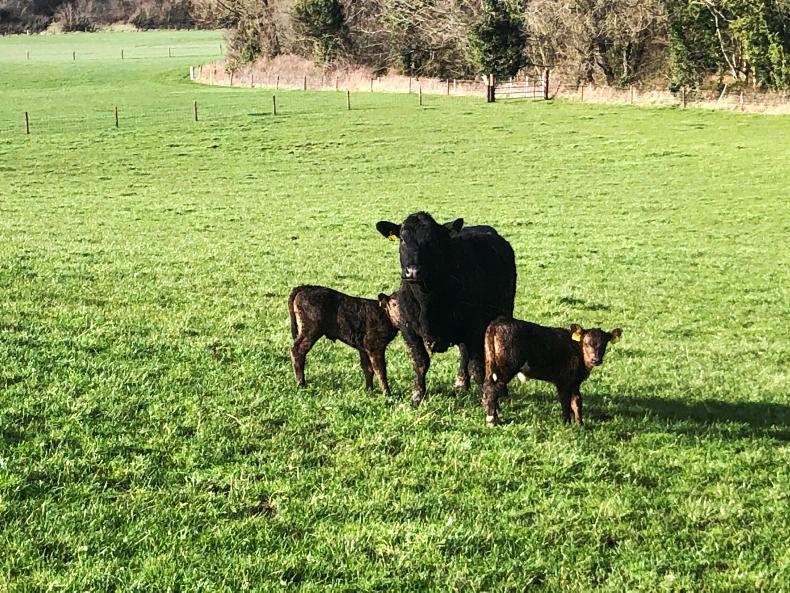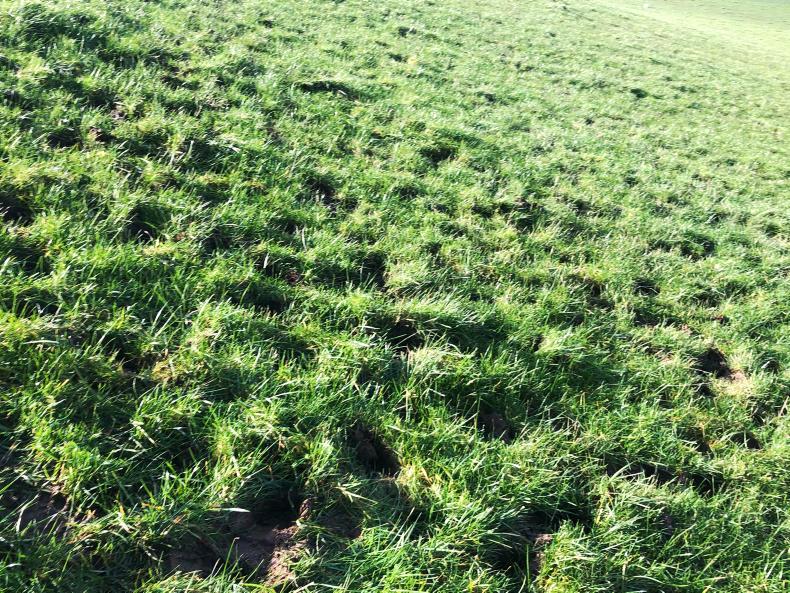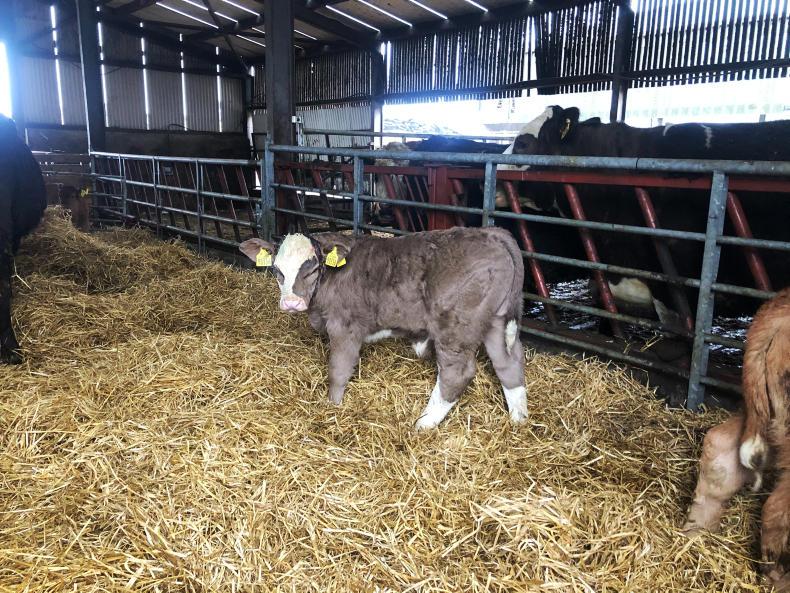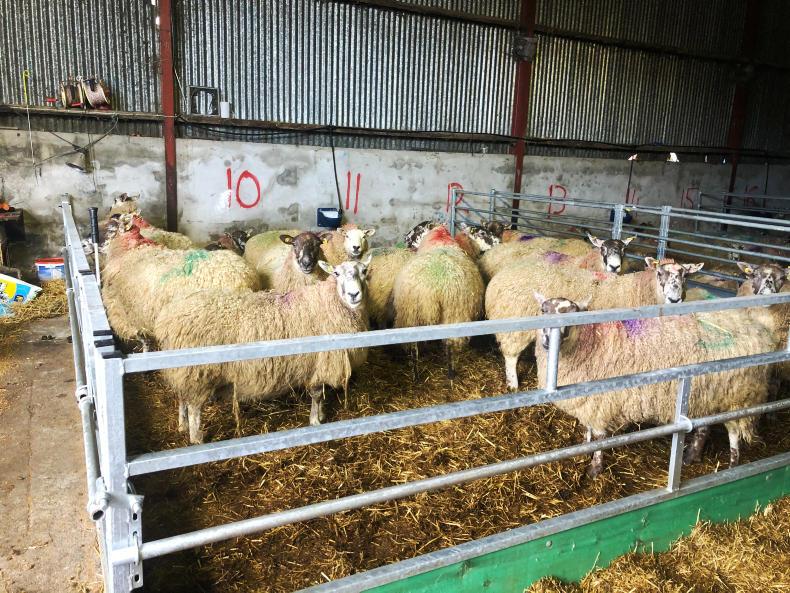One of the wettest Februarys on record is taking its toll on beef farms around the country, with turnout delayed and sheds now full to capacity on many farms. With land waterlogged, and further heavy rain forecast for the weekend, turnout is not likely to happen any time soon on many farms, especially in the west.
Listen to "Dealing with the weather on Tullamore farm" on Spreaker.
Tullamore Farm is encountering similar issues, with poor weather hampering turnout in the last few weeks. Some Offaly farmers along the Shannon are dealing with a lot worse, with flooded slatted sheds and silage pits and you need to keep things in perspective when dealing with issues. It is nonetheless challenging and the current weather has put a stay on a lot of plans on the farm this spring.
Calving
Calving started on 4 February and, to date, 64 cows have calved. Calving has gone well, with most cows calving unassisted and no issues with colostrum or milk. There have been two losses out of the 56 calved. One was a large Simmental calf that was calved alive but died after a few hours. The other was a heifer that had a foot down and the calf was born dead.
Cows are moved on to straw bedding before calving and generally calve in the large pens and are then moved across to the individual pens.

Cows have been turned out in small groups of six to seven.
“With four individual calving pens, there are days where you would like to give a first-calved heifer longer in the individual pen and we have one issue with a heifer where she hasn’t taken to the calf because we didn’t give her long enough in the pen. It’s probably something we need to look at next year,” Shaun said. Part of the plan is to go to grass as soon as possible after calving but weather has halted these efforts this year.
Slurry
Tanks are filling up fast, especially where cows are housed. Shaun has tried to eliminate any clean water getting into tanks to slow down tanks filling. “We’re very lucky in that we got out a lot of slurry in January with a trailing shoe slurry spreader. This relieved a lot of pressure and meant that we haven’t had to move any slurry until this week. The plan would have been to go with more slurry in early March but this looks likely to be later in March at this stage and it will probably go straight onto silage ground,” Shaun said.

Cows have been turned out to the driest most sheltered paddocks.
Space
Shed space is at a premium at the moment. A temporary creep area has been constructed in the centre passage of the three-bay double-slatted shed. This means cows can be housed on slats with calves having access to the straw-bedded creep area. This is working well. However, there have been a few cases of mastitis in heifers. This happened where teats have become dirty and the calf has failed to suck them.
Slats are being scraped twice daily and lime is being applied to try to keep teats clean. Straw usage is not being restricted with the creep area bedded every few days. Calving pens are also being cleaned out every two to three days to avoid disease buildup.

Calves are being herded closely with navels being checked regularly.
A big focus is being put on colostrum and getting it into calves. Calves are also herded daily with an eye kept that all are getting up and stretching and, more importantly, sucking.
Turnout
Twenty cows and calves have been turned out last weekend in small groups of six to seven cows per group. It isn’t ideal from a grassland management point of view but there was no other option. Once weather conditions improve, cows will be separated into bigger groups. Over the weekend, conditions were good weather wise so calves have had a chance to harden up before this weekend’s rain comes.
Calves have all been dehorned before turnout and also received their first shot of Bovipast as part of their pneumonia vaccination programme. Cows also received a high-magnesium bolus to cover against tetany.
Sheep
All sheep have been housed at this stage and this has added to the housing pressure around the yard. Triplets are currently being fed 0.9kg/day of concentrates, twins are on 0.7 kg/day/concentrates and singles are getting 0.4kg/day. All ewes received their Heptavac vaccine two weeks ago. The first lambs are due around 16 March.

All sheep have been housed and are being fed concentrates on straw-bedded housing.
Make sure all calves are receiving adequate colostrum, at least three litres per calf inside two hours of birth.Make sure that all calving pens/creep areas are adequately bedded.Herd calves very closely. Make sure that all calves are getting up, stretching and sucking.If turning out, make sure it’s a sheltered paddock.Make sure all calves are keeping up with cows.Protect against tetany: bolus, feed hay/silage or feed Cal-Mag.
One of the wettest Februarys on record is taking its toll on beef farms around the country, with turnout delayed and sheds now full to capacity on many farms. With land waterlogged, and further heavy rain forecast for the weekend, turnout is not likely to happen any time soon on many farms, especially in the west.
Listen to "Dealing with the weather on Tullamore farm" on Spreaker.
Tullamore Farm is encountering similar issues, with poor weather hampering turnout in the last few weeks. Some Offaly farmers along the Shannon are dealing with a lot worse, with flooded slatted sheds and silage pits and you need to keep things in perspective when dealing with issues. It is nonetheless challenging and the current weather has put a stay on a lot of plans on the farm this spring.
Calving
Calving started on 4 February and, to date, 64 cows have calved. Calving has gone well, with most cows calving unassisted and no issues with colostrum or milk. There have been two losses out of the 56 calved. One was a large Simmental calf that was calved alive but died after a few hours. The other was a heifer that had a foot down and the calf was born dead.
Cows are moved on to straw bedding before calving and generally calve in the large pens and are then moved across to the individual pens.

Cows have been turned out in small groups of six to seven.
“With four individual calving pens, there are days where you would like to give a first-calved heifer longer in the individual pen and we have one issue with a heifer where she hasn’t taken to the calf because we didn’t give her long enough in the pen. It’s probably something we need to look at next year,” Shaun said. Part of the plan is to go to grass as soon as possible after calving but weather has halted these efforts this year.
Slurry
Tanks are filling up fast, especially where cows are housed. Shaun has tried to eliminate any clean water getting into tanks to slow down tanks filling. “We’re very lucky in that we got out a lot of slurry in January with a trailing shoe slurry spreader. This relieved a lot of pressure and meant that we haven’t had to move any slurry until this week. The plan would have been to go with more slurry in early March but this looks likely to be later in March at this stage and it will probably go straight onto silage ground,” Shaun said.

Cows have been turned out to the driest most sheltered paddocks.
Space
Shed space is at a premium at the moment. A temporary creep area has been constructed in the centre passage of the three-bay double-slatted shed. This means cows can be housed on slats with calves having access to the straw-bedded creep area. This is working well. However, there have been a few cases of mastitis in heifers. This happened where teats have become dirty and the calf has failed to suck them.
Slats are being scraped twice daily and lime is being applied to try to keep teats clean. Straw usage is not being restricted with the creep area bedded every few days. Calving pens are also being cleaned out every two to three days to avoid disease buildup.

Calves are being herded closely with navels being checked regularly.
A big focus is being put on colostrum and getting it into calves. Calves are also herded daily with an eye kept that all are getting up and stretching and, more importantly, sucking.
Turnout
Twenty cows and calves have been turned out last weekend in small groups of six to seven cows per group. It isn’t ideal from a grassland management point of view but there was no other option. Once weather conditions improve, cows will be separated into bigger groups. Over the weekend, conditions were good weather wise so calves have had a chance to harden up before this weekend’s rain comes.
Calves have all been dehorned before turnout and also received their first shot of Bovipast as part of their pneumonia vaccination programme. Cows also received a high-magnesium bolus to cover against tetany.
Sheep
All sheep have been housed at this stage and this has added to the housing pressure around the yard. Triplets are currently being fed 0.9kg/day of concentrates, twins are on 0.7 kg/day/concentrates and singles are getting 0.4kg/day. All ewes received their Heptavac vaccine two weeks ago. The first lambs are due around 16 March.

All sheep have been housed and are being fed concentrates on straw-bedded housing.
Make sure all calves are receiving adequate colostrum, at least three litres per calf inside two hours of birth.Make sure that all calving pens/creep areas are adequately bedded.Herd calves very closely. Make sure that all calves are getting up, stretching and sucking.If turning out, make sure it’s a sheltered paddock.Make sure all calves are keeping up with cows.Protect against tetany: bolus, feed hay/silage or feed Cal-Mag. 









 This is a subscriber-only article
This is a subscriber-only article









SHARING OPTIONS: